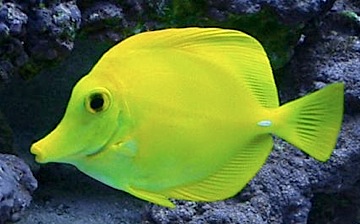The yellow tang (Zebrasoma flavescens) is a saltwater fish species of the family Acanthuridae. It is one of the most popular aquarium fish.
Yellow tang are in the surgeonfish family. Adult fish can grow to 20 centimetres (7.9 in) in length, and 1–2 centimetres (0.39–0.79 in) in thickness. Adult males tend to be larger than females. All individuals of this species are bright daffodil yellow in color. At night, the yellow coloring fades slightly and a prominent brownish patch develops in the middle with a horizontal white band. They rapidly resume their bright yellow color with daylight.
They have an arrow-like shape due to their dorsal and ventral fins being almost an extension to their bodies, and a long snout-like mouth used (as with other tangs) to eat algae. They also have a sharp spine located near their tail. They have become a popular fish for marine aquarists of all skill levels, as the fish tends to be active, hardy, and nonaggressive when kept with dissimilar species.
In the wild, yellow tang feed on benthic turf algae and other marine plant material. In captivity they are commonly fed meat/fish based aquarium food, but the long term health effects of this diet are questionable.[citation needed] In the wild, yellow tang provide cleaner services to marine turtles, by removing algal growth from their shells.
(From Wikipedia, 29 July 2011)
—
—
Yellow tangs, Zebrasoma flavescens, are reef fish found in the waters west of Hawaii and east of Japan in the Pacific Ocean. They mainly live off the coast of Hawaii, but are also found in the more western ranges of their habitat, including the islands Ryukyu, Mariana, Marshall, Marcus, and Wake. They prefer subtropical waters.
Inhabits coral-rich areas of lagoon and seaward reefs from below the surge zone to about 46 m. Occurs singly or in loose groups and browses on filamentous algae. A popular aquarium fish and the top marine fish export from Hawaii. Group spawning and pair-spawning by territorial males that court passing females were observed. Presence of a venom gland could not be determined despite the presence of distinct anterolateral grooves; this may be due to the loss of venom glands in adults .
(From EOL, 29 July 2011)





